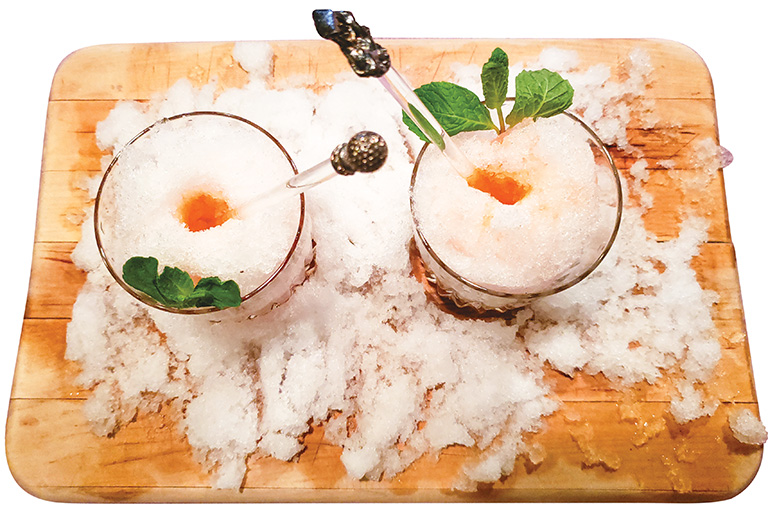When life hands you snow, add some lemon to it
By Ari LeVaux
Way back before the holidays, when winter first began sliding its icy fingers down our necks, we still had the holidays ahead. But once they were over, we had nothing to look forward to but snow—and that’s when the emotional work of winter really begins.
Enthusiasts of snow-based sports can slide down mountains, dressed in layers, while connoisseurs of rich and hearty meals can continue in their ways, justifying the diet as seasonal. But it’s the aforementioned snow that is the real seasonal treat. If you know how to prepare it, your winter will get a lot more interesting. Then, whenever life gives you snow, you can make yellow snow to enjoy.
Lemonade snow, that is. Along with other snowy treats, such as brown snow. Or red snow.
Sure, most people opt for a steaming cup of tea, or some other hot beverage, to balance the chill of winter. But to eat snow in winter is to face reality head on and consume it. You become part snow.
The snow where I live is so local you can’t throw a rock without hitting it, not that it cares if you do. All you need to do is walk outside and collect some. It’s like living on a farm, though perhaps insinuating snow to be food is a stretch, because it contains zero calories.
What snow provides is a context for calories to happen, sort of like the children’s story where the hero cooks a pot of water with a rock in it and calls it Stone Soup. The villagers want to partake in his soup, and the hero welcomes them, asking only that they bring something to add to the pot. Pretty soon, a delicious meal is ready that feeds a whole village.
Booze is in season, too, by the way. And a multitude of adult beverages are possible on snow. One could even do an adult version of the Stone Soup story, but with mixed-booze snow cones. Actually, scratch the adult stone cone idea. I did something like that in high school, with ice and the contents of my friend’s parent’s liquor cabinet, and it didn’t end well.
But you could invite your friends to visit, bringing with them their favorite juices and sweeteners and other flavorings for our snow—sweet and tangy flavors, and perhaps bitter and creamy as well.
Like snow and vodka, lemons are in season, as are limes, which I actually prefer, as well as oranges, pomegranate, grapefruit and more.
And we can’t forget the next holiday we have to look forward to. Indeed, chocolate is in season as well.
The trick with all of these recipes is to start with clean, fresh snow and keep it as structurally intact as possible. Begin with chilled cups to keep the snow cold. Quickly add the dry ingredients, stirring them in. Add liquids last, a splash at a time.
For yellow snow, sprinkle a teaspoon of sugar into a glass of loosely packed snow. Carefully mix it with a spoon. All of the snow does not need to be thoroughly mixed top-to-bottom. As long as the sugar is evenly mixed in the top third of the glass it will be OK. Then, squeeze a quarter of lemon or lime on top. Gingerly mix more sugar with the spoon and begin eating.
Eating a snow cup requires some effort. You poke it and prod it, like stoking a fire. A lemonade snow cup is a completely dazzling way of experiencing two basic flavors: acid and sugar. The flavor is brighter than in your typical lemonade. The acid of the lemon or lime is separated from the sugar by the snow, which insulates these opposing flavors from one another—akin to a battery. They finally are connected through your tongue, which tingles with flavored electricity.
For chocolate or mocha snow, start by mixing a teaspoon each of sugar and cocoa powder into a cup of snow. Add a drop of vanilla, and a tablespoon or more of heavy cream. Gently mix in the cream.
If chocolate snow is the goal, start eating. For a mocha snow, add a splash of cold or room-temperature coffee. If you end up adding too much coffee and the snow starts melting, add more snow and stir it back to a snowy consistency. It’s just short of rocket science.
But before we get too focused on Valentine’s Day, there is still the matter of Groundhog Day. So, I’ll leave you with a recipe for gin-and-pomegranate snow or vodka-cranberry snow. You can, of course, create a kids’ version.
Start by chilling some clean, dry glasses in the freezer. When frozen, pack them with snow and return to the freezer. When ready to serve, toss a teaspoon sugar into a glass and thoroughly mix it in with the snow in the upper reaches of the glass. Then begin working in squirts of lime and splashes of pomegranate juice and gin (or booze of your choice). Work it around, adjusting as necessary with sweet and sour, booze and snow, until it’s just right. Then bundle up and get comfy.
Stir. Sip. Prod. Add snow. Wait for the groundhog to come out of his hole. Depending on where you live, that might take a while, assuming there are even groundhogs ready to emerge on Feb. 2. If you need to take a break, pop it in the freezer.
Rinse and repeat until all of the snow is gone.



